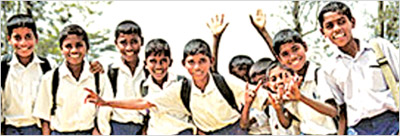Lanka has only tiny proportion of ‘out of school’ children – UNICEF
report
Sri Lanka has an excellent record of admissions of children aged five
to 14 years to schools, following seven decades of universal free
primary and secondary school education, says the ‘Country Study: Out of
School Children in Sri Lanka’ report.
This ‘Out of School Children Study in Sri Lanka’ is part of the
Global Initiative on Out of School Children launched by UNICEF and the
UNESCO Institute for Statistics in 2010.
 Its objectives are to explore currently available statistical
information Its objectives are to explore currently available statistical
information
on out of schoolchildren (OOSC), identify factors that contribute to
exclusion from schooling, and examine existing policies effective in
enhancing participation as well as the gaps in policy and in the
implementation of policies and programmes.
The three main data sources used were the Demographic and Health
Survey (DHS) 2006/07, the Annual School Census 2010 and the Child
Activity Survey 2008/09.
According to the DHS, 2006/07, it was concluded that Sri Lanka has a
relatively small proportion of out of schoolchildren -1.5 percent ofthe
primary school age children and 2.0 percent of the lower secondary
school age (Department of Census and Statistics, 2006), the report said.
The more recent and representative survey of Household Income and
Expenditure, 2009/10 (Department of Census and Statistics, 2011)
reported that 98.2 percent of boys and girls in the five to 14 age group
(primary and lower secondary levels) were in school-98.6 percent in the
urban sector, 98.3 percent in the rural sector and 95.6 percent in the
estate sector, the report added. Those who never attended school were
1.0 percent of the age group and those who dropped out were 0.8 percent,
the highest percentages were 2.0 percent and 2.3 percent in the estate
sector.
Gender disparities in education have largely been eliminated in Sri
Lanka as a result of the long-standing policy of free education. In
fact, girls have higher retention rates than boys. By the end of the
1960s, there were more girls than boys in upper secondary grades as boys
tended to dropout early to join the labour force and girls continued in
schools in the context of the provision of free education.
In 2009, 57.5 percent of those enrolled in Grades 12 and 13 were
girls (MOE, 2009a).
Clearly, the preponderance of coeducational schools (96.6 percent)
has accelerated progress towards gender parity.
Sri Lanka has achieved the third Millennium Development Goal of
eliminating disparities in enrollment in education in primary, secondary
and tertiary education as a consequence of the positive social policies
implemented over many decades, the report adds.
|





